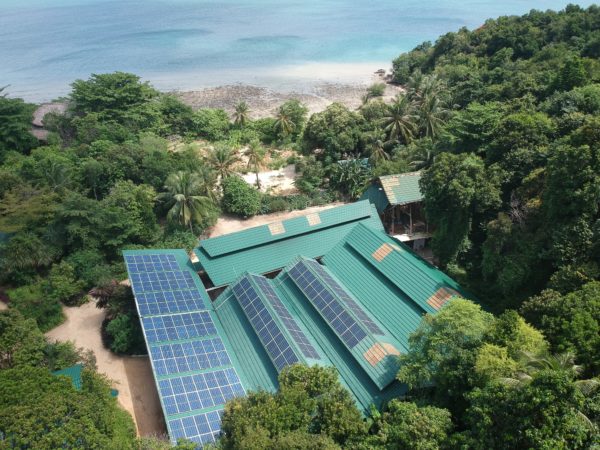Singapore renewables micro-grid start-up Canopy Power last summer installed two solar-plus-storage mini-grids on private islands in Indonesia.
Nikoi and Cempedak are 10km and 14km, respectively, from the nearest grid connection operated by the state-owned utility, which is on the island of Batam, 85km from Singapore.
“The idea of a submarine cable for a single resort is a non-starter,” a Canopy spokesperson told pv magazine. “It’s not even on the table as an option from local utility and grid operator PLN, and would not be commercially viable.”
Twin projects
The project on Nikoi is based on 52.5 kW, TwinPeak REC350TP2S 72-cell monocrystalline modules supplied by Norwegian manufacturer REC Solar, two STP20000 inverters from German manufacturer SMA, and a 77 kWh lithium storage system from Germany’s Tesvolt. The Canopy Power Hornbill Base remote management system was provided by the developer.
The solar-plus-storage plant is said to supply around half of Nikoi’s energy needs with an annual generation capacity of around 60.1 MWh which should reduce annual diesel consumption by around 19,000 liters.
The Cempedak project boasts an identical spec and performance and was commissioned a month later, in July last year.
Lower energy price
Canopy said the projects could provide up to 85% of the island resorts’ power needs. “Load management could potentially increase this further to around 90% but reaching 100% is not practical in most cases due to the space required for solar PV and the current cost of battery systems,” the company said.
The price of solar electricity is already much lower than diesel in Indonesia. According to the developer, the levelized cost of energy produced by solar mini-grids in the country is around $0.22/kWh. Diesel stands at $0.30/kWh.
Indonesia provides support to similar projects but the two island systems are subsidy-free. “Canopy Power’s solutions are private and so are not under [the] regulation of PLN,” the spokesperson said. “Customers, including Nikoi and Cempedak, do not receive any support, fiscal breaks or subsidies.”
The Indonesian government is hoping to use micro and mini-grids for the island nation’s less electrified areas. The country’s first three solar-plus-storage mini-grids were commissioned in June 2017, three months after the government had introduced a renewables policy.
Electricity access
The Asian Development Bank says 15% of Indonesia’s population – around 10 million people – had no access to electricity in 2016. The government wants all its citizens to have access to power next year.
A report published by Canadian thinktank the International Institute for Sustainable Development stated Indonesia has no more than 80 MW of installed solar generation capacity, with 64 MW made up from off-grid systems in remote areas. “The current installed base is almost exclusively made up of small units that lack the economies of scale associated with the industrial scale solar units commonly found in other countries,” the report noted.
The authors of that paper said the PLN has limited spare grid capacity but added: “However, no one is asking for the grid to absorb large amounts of intermittent power immediately. Even though the grid and its management definitely needs updating, it could absorb intermittent power in its infancy while [the] PLN learns how to manage a future grid with more intermittent power, perhaps even in large amounts, eventually.”
Indonesia could deploy up to 655 GWp of rooftop solar, said the nation’s electricity sector reform body the Institute for Essential Services Reform recently. That figure was based on solar resource mapping carried out using the Renewable Energy Data Explorer tool developed by the United States National Renewable Energy Laboratory.
This content is protected by copyright and may not be reused. If you want to cooperate with us and would like to reuse some of our content, please contact: editors@pv-magazine.com.




2 comments
By submitting this form you agree to pv magazine using your data for the purposes of publishing your comment.
Your personal data will only be disclosed or otherwise transmitted to third parties for the purposes of spam filtering or if this is necessary for technical maintenance of the website. Any other transfer to third parties will not take place unless this is justified on the basis of applicable data protection regulations or if pv magazine is legally obliged to do so.
You may revoke this consent at any time with effect for the future, in which case your personal data will be deleted immediately. Otherwise, your data will be deleted if pv magazine has processed your request or the purpose of data storage is fulfilled.
Further information on data privacy can be found in our Data Protection Policy.